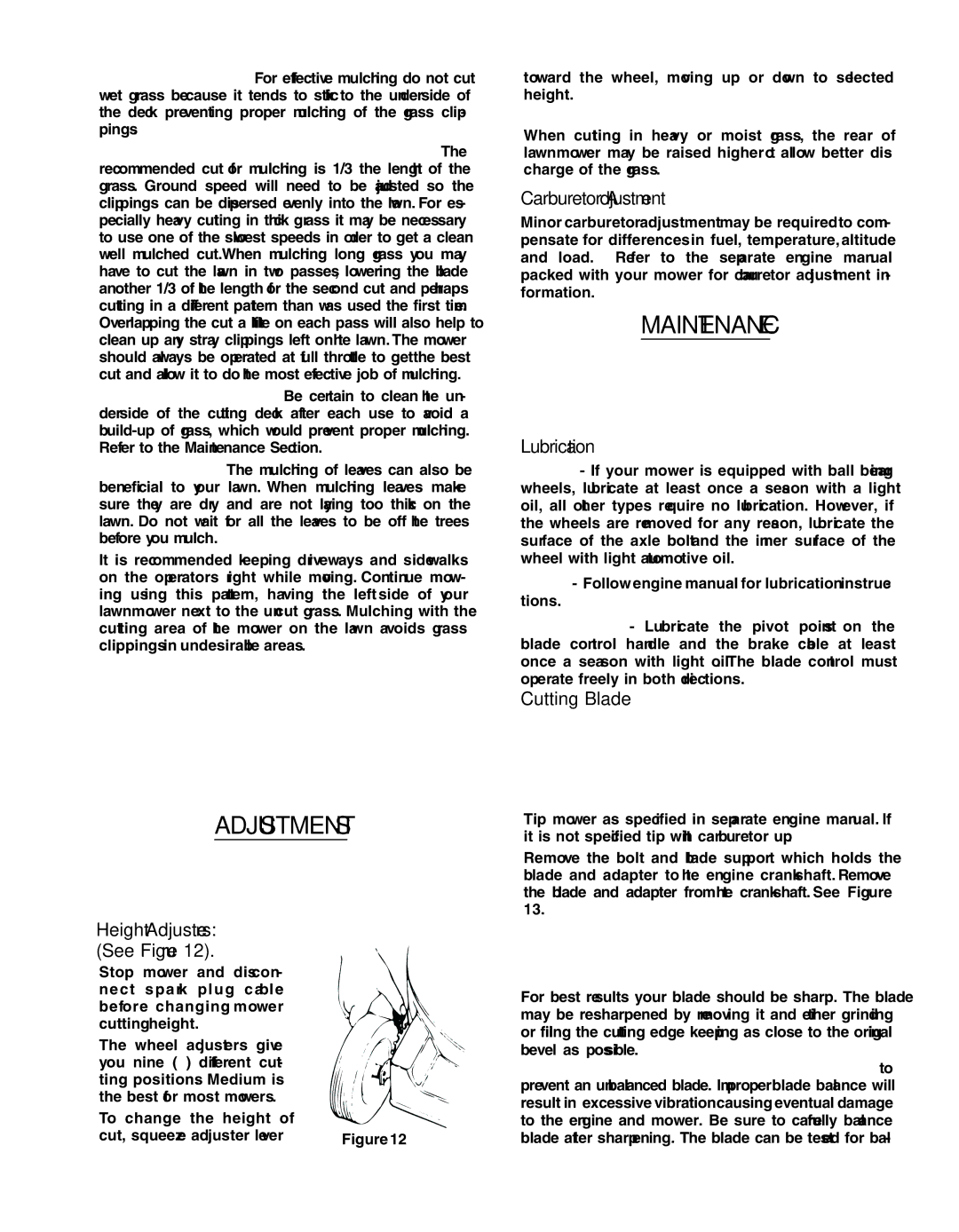
•Do not cut wet grass. For effective mulching do not cut wet grass because it tends to stick to the underside of the deck preventing proper mulching of the grass clip- pings.
•Cut no more than 1/3 the length of the grass. The recommended cut for mulching is 1/3 the length of the grass. Ground speed will need to be adjusted so the clippings can be dispersed evenly into the lawn. For es- pecially heavy cutting in thick grass it may be necessary to use one of the slowest speeds in order to get a clean well mulched cut. When mulching long grass you may have to cut the lawn in two passes, lowering the blade another 1/3 of the length for the second cut and perhaps cutting in a different pattern than was used the first time. Overlapping the cut a little on each pass will also help to clean up any stray clippings left on the lawn. The mower should always be operated at full throttle to get the best cut and allow it to do the most effective job of mulching.
•Clean underside of deck. Be certain to clean the un- derside of the cutting deck after each use to avoid a
•Mulching Leaves. The mulching of leaves can also be beneficial to your lawn. When mulching leaves make sure they are dry and are not laying too thick on the lawn. Do not wait for all the leaves to be off the trees before you mulch.
•It is recommended keeping driveways and sidewalks on the operators right while moving. Continue mow- ing using this pattern, having the left side of your lawnmower next to the uncut grass. Mulching with the cutting area of the mower on the lawn avoids grass clippings in undesirable areas.
WARNING: If you strike a foreign object, stop the engine. Remove wire from spark plug, thor- oughly inspect the mower for any damage, and repair the damage before restarting and operat- ing the mower. Extensive vibration of the mower during operation is an indication of damage. The unit should be promptly inspected and re- paired.
ADJUSTMENTS
WARNING: Always stop engine, disconnect spark plug and ground against engine before performing adjustments.
Height Adjusters:
(See Figure 12).
•Stop mower and discon-
nect spark plug cable before changing mower cutting height.
• The wheel adjusters give you nine (9) different cut- ting positions. Medium is the best for most mowers.
• To change the height of |
|
cut, squeeze adjuster lever | Figure 12 |
toward the wheel, moving up or down to selected height.
NOTE: All wheels must be in the same height of cut.
•When cutting in heavy or moist grass, the rear of lawnmower may be raised higher to allow better dis- charge of the grass.
Carburetor Adjustment
Minor carburetor adjustment may be required to com- pensate for differences in fuel, temperature, altitude and load. Refer to the separate engine manual packed with your mower for carburetor adjustment in- formation.
MAINTENANCE
WARNING: Always stop engine, disconnect spark plug and ground against engine before cleaning, lubricating or doing any kind of main- tenance on your machine.
Lubrication
Wheels - If your mower is equipped with ball bearing wheels, lubricate at least once a season with a light oil, all other types require no lubrication. However, if the wheels are removed for any reason, lubricate the surface of the axle bolt and the inner surface of the wheel with light automotive oil.
engine - Follow engine manual for lubrication instruc- tions.
Blade Control - Lubricate the pivot points on the blade control handle and the brake cable at least once a season with light oil. The blade control must operate freely in both directions.
Cutting Blade
WARNING: Be sure to disconnect and ground the spark plug wire before working on the cut- ting blade to prevent accidental engine starting. Protect hands by using heavy gloves or a rag to grasp the cutting blade.
•Tip mower as specified in separate engine manual. If it is not specified tip with carburetor up.
•Remove the bolt and blade support which holds the blade and adapter to the engine crankshaft. Remove the blade and adapter from the crankshaft. See Figure 13.
WARNING: Periodically inspect the blade adapter for cracks, especially if you strike a for- eign object. Replace when necessary.
For best results your blade should be sharp. The blade may be resharpened by removing it and either grinding or filing the cutting edge keeping as close to the original bevel as possible. It is extremely important that each
cutting edge receives an equal amount of grinding to
prevent an unbalanced blade. Improper blade balance will result in excessive vibration causing eventual damage to the engine and mower. Be sure to carefully balance blade after sharpening. The blade can be tested for bal-
9
